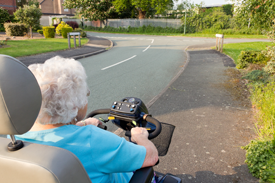Your mobility scooter

There have been a number of people injured in Road Traffic Collisions involving mobility scooters in recent years. In many cases the mobility scooter user tipped the vehicle or has fallen off.
What can you do to improve safety when using a mobility scooter?
Familiarise yourself with the controls of the vehicle - in a safe place, practise:
- going up and down raised surfaces and kerbs
- reversing and manoeuvring in tight spaces
Plan your route - the shortest route may not always be the easiest
- will the route you plan to take involve steep hills, high kerbs or other obstructions make it tricky to tackle?
Don’t drink and drive - don’t use your scooter if you have been drinking
- are you on medications that are making your feel drowsy? If so, do not use your scooter and if in doubt speak to your doctor
Be seen - even if only using pavements being more visible should make you safer
- it is recommended you wear higher visibility clothing
- all one colour is best without patterns
- the latest advice is to wear a sleeved jacket and not a waistcoat or tabard
- fluorescent is best for daylight and reflective is best in the dark
- take note that reflective will only work when a vehicles headlight shines directly on the reflective strip -you can’t be see side on
- why do I need to be seen if I’m just using pavements?
- vehicles cross pavements to get in / out of driveways - on your mobility vehicle you will be lower down making it harder for drivers to see you compared to someone who is walking
Wet weather gear – if you wear wet weather cover, be extra careful in windy conditions and follow the manufacturers guidance
Beware of loose fitting clothing or hanging shopping bags - they could become entangled in the scooter
Maintain and service your mobility scooter – pay attention to tyres and lights
Do I need insurance?
Though not legally required, it is recommended that you take out insurance cover.
- will you be financially affected if injured yourself?
- do you have funds to pay if you injure someone else or damage property?
Check if your mobility scooter is covered under your home insurance, as these vehicles may pose a fire risk.
You don’t need road tax for it, even if riding on the road.
Where should I store my mobility scooter?
Fires involving mobility scooters are relatively infrequent but when they do occur they can quickly produce significant heat and toxic smoke.
- if you can, keep mobility scooters outside
- where they must be kept within a building, a risk assessment should be carried out and appropriate control measures should be considered
Fire safety advice
- keep escape routes and communal walkways clear
- make sure you have working smoke alarms and a fire escape plan
- request a safe and well visit and we will visit you at your home and complete a Home Safety Check to help reduce the risk of fire in your home, such as checking and fitting smoke alarms and helping you make a fire escape plan
- more top tips and advice can be found on our at home pages
Do I need to register my mobility scooter with the DVLA?
- Class 3 mobility vehicles have to registered with Driver and Vehicle Licensing Agency (DVLA).
There are 3 classes of mobility vehicle
Class 1 - manual wheelchair
- self-propelled or attendant propelled, not motorised.
Class 2 - powered wheelchair or motorised scooter
- is a motorised vehicle for use on the pavement, with a top speed limit of 4mph
- you are not required to be registered this vehicle with the DVLA
Class 3 - powered wheelchair or motorised scooter
- is a motorised vehicle that is designed for use on the road with a speed limit of 8mph as well as the pavement with a speed limit of 4mph
- you must register your vehicle with the DVLA and are legally required to have:
- a speed limiting device to set the speed at maximum of 4mph for pavement travel
- a maximum speed of 8mph for road travel
- efficient braking system
- front and rear lights and reflectors
- direction indicators / hazard warning lights
- an audible horn
- rear view mirror
- amber flashing light if the vehicle is to be used on dual carriageway – this may be legal, but we discourage the use of mobility vehicles on dual carriageways
- un-laden weight maximum 150kg and maximum width of 0.85 metre
- users over 14 years of age
- if you do not comply with these rules for your Class 3 vehicle you could be stopped by Police
More information
For more information on rules of the road and registering motorised scooter or wheelchairs
